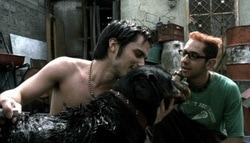

Ramiro is crude and cruel, denying Susana money for basics like diapers, although he'll present her with gifts that are stolen goods. Just as it seems they've lost the tailing vehicle - smash! The filmmakers have grabbed our attention.ĭecent guy Octavio is tender and flirtatious with Susana and her baby by his older brother Ramiro.

In the back seat lies a dog bleeding profusely. The film begins with Octavio at the wheel and buddy Jorge (Humberto Busto) riding shotgun as they're chased through city streets by a truck wielding a gun toting crazy. In a fit of rage Octavio stabs Jaricho in retaliation, which results in a return to the car chase and subsequent crash the film opens with.I'll be doggoned - this Mexican masterpiece is the feature film debut of both its director/producer Alejandro Gonzalez Inarritu and screenwriter Guillermo Arriaga. By portraying the tensions that persist for millions of Mexicans (rigid class division, lack of political agency, etc. According to Geoffrey Kantaris (2003: 186–7), the film uses dog-fighting as a displaced metaphor for human violence and impeded human relationships. Editors: Alejandro González Iñárritu, Luis Carballar, Fernando Pérez Unda. Amores Perros is a three segment story interconnected by a car accident. In fact, as De La Garza (2006: 152–3) argues, the film exposes the ‘contingency of identities’ by showing them as ‘unfixed’. The dogs mirror the psyche of the central protagonists and their fates within the film, with El Chivo remarking in one scene that, ‘Masters take after their dogs’ the allegory being that owners are just as helpless as their animals to change their situation. Synopsis Cinematographer: Rodrigo Prieto.

Young (eds), Contemporary Latin American Cultural Studies, London, Arnold, 2003, pp. Geoffrey Kantaris, ‘The Young and the Damned: Street Visions in Latin American Cinema’, in S. The central argument is that the film displays Mexican The central argument is that the film displays Mexican masculinities in both a transgressive and conventional fashion. Amores Perros (Alejandro González Iñárritu, Mexico, 2000). Amores Perros emphasises the uneven development and overcrowded landscape of Mexico City, which plays host to nearly nine million inhabitants. During his reconnaissance of ‘the mark’, El Chivo witnesses the aforementioned car crash. This leads to a complication of her injuries, the amputation of her leg and the end of her modelling career. One of the film’s central themes, loss and regret, reflects feelings of unease and insecurity which permeated Mexican society during the film’s production. The Routledge Encyclopedia of Films, Edited by Sarah Barrow, Sabine Haenni and John White, first published in 2015. Octavio is infatuated with his teenage sister-in-law Susana, who, along with Octavio’s mother, brother and Susana’s baby son, live together in a crowded apartment. Production Company: Altavista Films, Zeta Films. in retrospect Disney killed more animals by then Throughout the film El Chivo is seen caring for a group of stray dogs, whilst also appearing at the funeral of his ex-wife where he sees his daughter Mura for the first time since he abandoned his family to ‘set the world right’. AMORES PERROS - STUDENT ANALYSISA frantic and dramatic car chase through the streets of Mexico City,resulting in a traumatic crash at a crossroads throws viewers intoAlejandro González Iñárritu’s debut masterpiece, AmoresPerros (Love’s aBitch).Set in the heart of Mexico City, the anthology-pieced film portrays thetales of three individuals of separate social classes who are linked … The plot brings together the lives of three sets of people because of one accident. Daniel and Valeria's new-found bliss is prematurely ended when she loses her leg in the accident. In the process, she teams up with an unlikely figure from her past to bring down the leader of … Amores Perros, in particular, is opaque and multi-layered, raising questions about fate and love with a lightness of touch, with metaphor and gentle, visual suggestion. Amores perros drew widespread attention to and condemnation of the cruel practice of dog fighting in Mexico. He cleans himself up, cuts his hair and nails before breaking into Mura’s home to leave her money and a voicemail apologising for his abandonment. On the brink of the new Millennium in the bustling City of Mexico, one horrible car accident intertwines inextricably the lives of three perfect strangers. This ending underscores the film’s social context symbolising contemporary Mexico where marginalisation and inequality still exist, offering no indication this way of life will change in the near future. Lindsay Peters, ‘Private Fears in Public Places: Network Narrative and the Post-“Smart” American Melodrama’, Synoptique, Vol. Rather than killing the businessman he was hired to assassinate he kidnaps both men, placing a gun between them, leaving them to resolve the situation themselves.


 0 kommentar(er)
0 kommentar(er)
